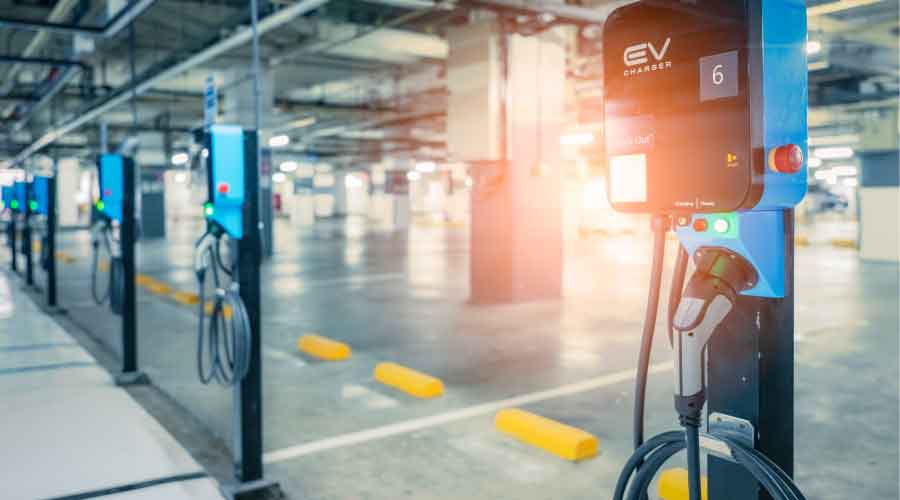Practical Considerations for EV Charging Station Installation
Cost, location, and ongoing maintenance all must be thought through when building owners are installing Electric Vehicle Supply Equipment.
By Elbert Walters III, Contributing Writer
A recent FacilitiesNet piece titled How to Prepare Buildings for the Electric Vehicle Boom the EV at the EV landscape and made the case for adding electric vehicle supply equipment (EVSE) — commonly called charging stations or charging docks — to your properties. As EVs continue to rise in prominence, offering EV charging at your business or workplace will soon be a necessity.
But the considerations around EVSE can bring more questions than answers. Questions like who pays for the equipment, installation, and ongoing maintenance. There are also questions about design considerations like deciding where to locate the EV charging stations.
“Many customers are in the energy assessment phase to determine if they have existing infrastructure that they’ll be able to incorporate EV charging in the next couple of years. Most organizations are assessing and, if needed, improving their infrastructure to prepare for future installs,” says Nick Pupich, Director of Controls and Specialized Solutions at Chicago-based Connelly Electric.
Pubich notes that recent grants and incentives have been driving customers to assess their EV needs but those assessments aren’t always resulting in installation yet. Pupich emphasizes the importance of the energy assessment phase and advises that if installing EVSE infrastructure is something you’d like to consider in the next few years, now is the time to begin working with a qualified electrical contractor.
What’s The Cost?
Installing EV infrastructure is an investment in the future. But the benefits don’t negate the substantial cost of the equipment and installation. Of course costs vary depending on the type of charging stations, some Level 2s can cost $6,000 per unit while more high-end Level 2 units may range from $10,000 to $30,000 per unit. Level 3 fast chargers are the priciest, ranging from $40,000 to $175,000 per unit. These are just equipment costs. Depending on your facility’s electrical capacity, it may be prudent to upgrade your electrical infrastructure before installing the chargers.
For a more specific cost estimate, use the National Electrical Contractors Association (NECA)’s database to find a qualified, International Code Council (ICC)-certified and Electric Vehicle Infrastructure Training Program (EVITP)-certified electrical contractor nearby who can perform an initial site assessment. This assessment will provide insights into needed infrastructure upgrades, project costs and a construction timeline. Additionally, a great contractor will help you find all available grants, rebates and tax incentives that can help offset initial capital expenses.
Who pays for electric vehicle charging stations?
Before you decide to proceed with your EVSE project, you may be wondering who typically pays — the property owner or the tenant. While each situation is unique, it’s most common that the property owner pays for the EVSE equipment, installation and maintenance. A new trend of late is the landlord provides the infrastructure and then the tenants pay for the EVSE installation, usually in addition to a monthly kWh fee. Additionally, sometimes property owners choose to charge tenants a monthly renewable energy.
Design considerations for EVSE
Next to costs, the second most common question is around design considerations for EVSE. Before determining where the equipment goes, you’ll first need to identify how many parking spaces you’d like to equip. Make sure to consider your current and future EV charging needs, your organization’s sustainability goals and local code requirements when deciding the scope of your EV project.
Once you know how many EV-equipped or EV-ready spots you’d like to have, determining the locations of your chargers is key. When able, it’s best to plan a location that is closest to the electrical panel. A longer distance will increase the need for trenching and wiring, which could increase installation fees. Additionally, it’s best to install EVSE outside of parking garages to mitigate the risk of costly EV fires. From a logistical standpoint, it’s also wise to consider installing charging stations by building entrances, areas that are well-lit, and locations with a reliable Wi-Fi connection.
Ensuring EV charging stations are properly installed
Lastly, it’s crucial that you choose a contractor that’s trained in all aspects of EV installation. While there are many companies that you can hire to install charging stations, not all of them employ qualified electricians who are trained on the big-picture role that this equipment will play in your facility’s electrical infrastructure. Look for electrical contractors who are specially trained and have up-to-date knowledge of EV charging station installation and maintenance.
For help finding a contractor that’s specially trained and has up-to-date knowledge of EV charging installation and maintenance, check out the National Electrical Contractors Association’s searchable database. You can also download this EV charger installation e-book that provides a more detailed look at considerations for EV charging.
With several incentives aimed at providing a more robust EV charging infrastructure and customers who are hungry for charging options, now is the time to take the next step to assess your facility’s EV infrastructure.
Elbert Walters III is Executive Director of Powering Chicago.
Related Topics:












